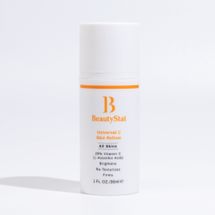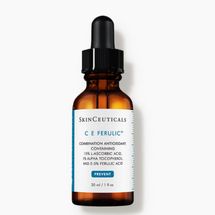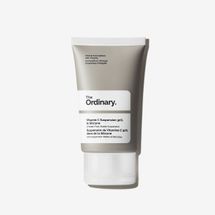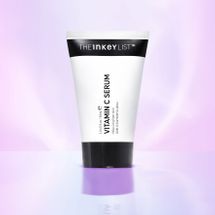
Is a low price a red flag when it comes to judging the effectiveness of a vitamin-C serum? Not necessarily. Why not? Some companies sell it for $4.82, others charge $375, but “at the end of the day, the cost comes down to marketing and branding” and “technical merit,” or the amount of money put into researching the formulation, according to cosmetic chemist Ginger King, president of the product-development firm Grace Kingdom Beauty. (If a company spends a lot of money developing and patenting a special form of vitamin C, it needs to recoup that money by building the costs into the price of each product.)
At the risk of giving every dermatologist and chemist reading this column a heart attack, I’m going to share a ridiculously oversimplified scenario to prove that cheap products can be effective: One kilogram of L-ascorbic acid (the purest form of vitamin C) at 30 percent potency (the highest level available in stores) costs a cosmetic company about $9, according to a product formulator I spoke with. That means the company could hypothetically put 30 cents of vitamin C into a one-ounce serum that does indeed do something, sell it to you for $8, and still make a profit. But that example glosses over a lot of important info, including some things you might want to know when you’re selecting your next serum.
So what does vitamin C do? At low levels, it acts as an antioxidant, protecting your skin from future damage. But at more potent levels, the ingredient can correct damage that has already happened: It will make your skin look brighter (by reducing the appearance of hyperpigmentation) and smoother (by stimulating the production of collagen), according to chemist Allen Sha, the founder and managing partner of the product-development firm Sha Consulting Group. But there are dozens of variables that affect vitamin C’s potency, including the form, how it’s formulated, and even the package it comes in.
When it comes to form, L-ascorbic is the most effective version of vitamin C because it’s pure (your skin doesn’t have to convert it to use it). But it’s notoriously unstable when exposed to light, air, or heat. Another form, 3-O ethyl ascorbic acid, is also very effective, in part because it’s much more stable, according to King. And a few other vitamin-C derivatives, like tetrahexyldecyl ascorbate, magnesium ascorbyl phosphate, and ascorbyl glucoside, can be pretty effective depending on how they’re formulated and stabilized, says Sha. But in an attempt to keep things simple, those are the five to look for.
Potencywise, you want a formula with 10 percent to 20 percent vitamin C, says cosmetic chemist Ron Robinson, the founder of BeautyStat. Higher levels are potentially better because they allow for a loss of potency owing to instability, but you can’t find anything in the U.S. above 30 percent, says King — and you wouldn’t want it anyway (high levels can be irritating).
Formulation is where things get (even) trickier. Many large companies do years of research and spend heaps of money to find ways to make vitamin C more stable so it remains potent as it sits unopened on store shelves — and for at least a few months after you start using it. (FYI: Sha recommends using any vitamin-C serum within three months of purchasing it.) The most famous example is probably SkinCeuticals’s C E Ferulic, which costs $169. The company patented a 15 percent L-ascorbic acid that’s stabilized with the help of vitamin E and ferulic acid — and, yes, that’s another oversimplification. Robinson’s company also makes serum — BeautyStat Universal C Skin Refiner ($85) — with a patented form of stabilized vitamin C that retains 20 percent potency for three to five years. Both are excellent products.
That’s not to say something less expensive, like the Inkey List’s 30 percent Vitamin C Serum ($10.99) or the Ordinary’s Vitamin C Suspension 30% in Silicone ($7.50), aren’t effective. Both are waterless formulas, which helps to keep them stable, according to King. But on the other hand, water-based formulas like SkinCeuticals’s “penetrate the skin quicker and better,” says Sha. I told you: It was tricky.
My advice? Buy from a reputable company that has a website with links to clinical research showing its products’ effectiveness, and make sure your serum comes in an opaque container (an airless-pump container is even better but will definitely increase the price). Then see how it works for you. Regardless of price, “if it works, then continue to buy it. If not, switch to a higher priced one and see if it makes a difference or vice versa,” says King.
One final word: If your vitamin-C serum smells or looks differently than the day you opened it, throw it out. “Those changes are indications of instability,” says Sha. I recently went to a friend’s house, and she pulled me into her bathroom to have me go through a shoe box of skin care she’d been using. She took out a vitamin-C serum and said she figured it must work because it had a weird color and smelled like “dirty hot-dog water” (IYKYK). The reason she hadn’t thrown it out? “I thought it was vitamins. So it wasn’t supposed to be nice to use.” She was wrong. The best vitamin-C serum is the one you actually use — because you like it.
Jennifer Sullivan answers all your beauty-related questions with practical advice and zero judgment. Send your questions to AskABeautyEditor@nymag.com. (By emailing, you agree to the terms here.)









